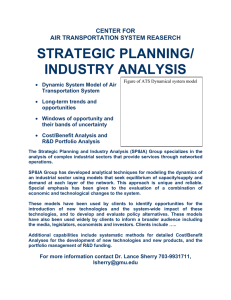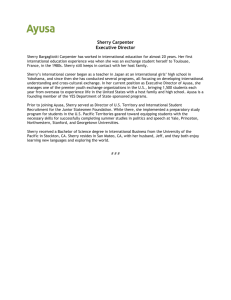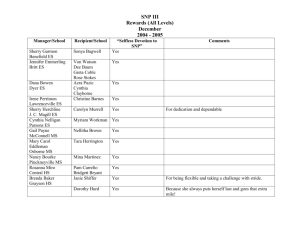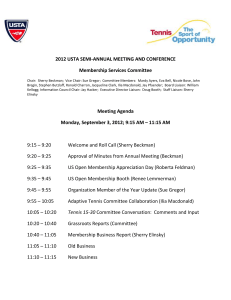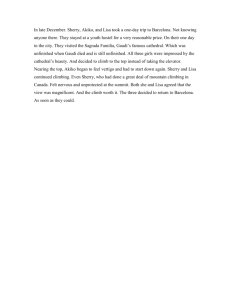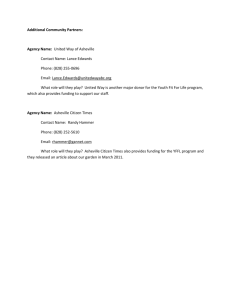Why the APTS has Delays: It’s the Economics, the Regulations, and
advertisement
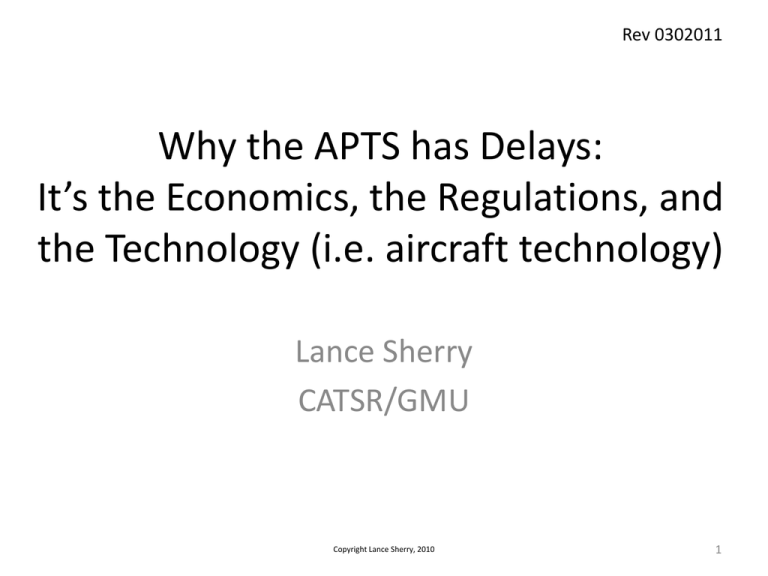
Rev 0302011
Why the APTS has Delays:
It’s the Economics, the Regulations, and
the Technology (i.e. aircraft technology)
Lance Sherry
CATSR/GMU
Copyright Lance Sherry, 2010
1
Every Market Pair has a Travel Demand
# Passengers
Time of Day
Number of passengers that have an interest in
travelling from Market A to Market B during each
time period.
2
Copyright Lance Sherry, 2010
Passengers Have Willingness-to-Pay
Travel if price low
…
…
…
…
Travel independent
of price
# Passengers
Time of Day
Passengers in each group will have an interest in
travelling based on the airfare – Willingness-toPay.
3
Copyright Lance Sherry, 2010
Willingness-to-Pay & Elasticity
# Passengers
Time of Day
# Passengers
Price vs Demand
Curve: Number of
passengers that will
travel at each price
point
Slope = Price Elasticity
• < -1 elastic, do not fly as price goes up
• > -1 inelastic, do not care about price
Q1
P1
Copyright Lance Sherry, 2010
Airfare
4
0
50
100
150
200
250
300
350
400
450
500
550
600
650
700
750
800
850
900
950
1000
1050
1100
1150
1200
1250
1300
1400
1450
1650
1700
1750
1800
1850
2000
2550
Demand
Airfare vs Demand Curve
IAD-DEN Demand vs. Price ($50 buckets)
700
600
500
400
300
200
100
0
Price
Copyright Lance Sherry, 2010
5
Cumulative Demand vs Airfare
Price-Demand Curve
# Passengers
Willingness-to-Pay Curve
Convert to Cumulative
Wilingness-to-Pay:
QLow
Start with P-Low to PHigh, compute the
Cumulative Pax
Demand, and then
compute the Weighted
Average Airfare. Plot
this point. Increase PLow, and repeat. The
result is an exponentail
PHigh
function.
QHigh
PLow
Cumulative
# Passengers
PWeighted Average Airfare
Individual Airfare
Weighted Average Airfare from PHigh to
PLom)
Cumulative # Passengers = ∑ (qi) = M *
exp (Coeff * (∑ (pi*qi) / ∑ (qi) )
6
Copyright Lance Sherry, 2010
Cumulative Demand vs Airfare
JFK-ATL WTP Curve
700
Theoretical # Pax at Airfare = Zero
y = 1529e-0.007x
R² = 0.9895
600
cum demand
Expon. (cum …
Cumulative Demand
500
Cumulative Demand = M * exp(Price*Coeff)
Cumulative Demand = 1529 * exp (Avg Airfare * -0.007)
400
300
200
Shape of exponential curve ~ elasticity
• less negative = inelastic
• more negative = elastic
100
0
0
200
400
600
800
Average Airfare
Copyright Lance Sherry, 2010
1000
1200
1400
7
Example Coefficients
Market
Market Size
Coefficient
Airfare Elasticity
Coefficient
Notes
JFK - ATL
1529
-0.007
Medium volume,
inelastic
JFK - MCO
7884
-0.011
High volume, very
elastic
JFK - ORD
344
-0.004
Low volume, very
Inelastic
Which Market Size, Airfare Elasticity would you rather have?
8
Copyright Lance Sherry, 2010
Cumulative Demand vs Airfare
Passengers not
scared-off by
higher prices
Passengers scaredoff quickly by higher
prices
9
Copyright Lance Sherry, 2010
Relationship between Demand and
Price
Demand = M * exp(Price*Coeff)
Solve for Price
Take natural log of both sides
Ln(Demand) = Ln(M) + Price*Coeff
Solve for Price
Price = (Ln(Demand) - Ln(M) )/Coeff
10
Copyright Lance Sherry, 2010
Maximizing Airline Revenue
What combination of Airfare
and Cumulative Passenger
Demand yields the greatest
Revenue
$32,088
$80,258
$56,170
11
Copyright Lance Sherry, 2010
Maximum Airline Revenue
Max Revenue:
2950 Pax, $196K Rev, $66.51 Airfare
12
Copyright Lance Sherry, 2010
Airline Costs
• Cost per Flight =
Landing Fee +
{Average Block Hours *
[Direct Operating Costs (not including fuel costs) +
(Burn Rate * Fuel Price)] }
• Costs to Satisfy Demand = Cost per Flight *
Number of Flights
13
Copyright Lance Sherry, 2010
Differences in Aircraft Performance
Aircraft Size
25
50
75
100
125
150
175
200
225
Fuel Burn
Rate
201.87
435.41
457.86
854.05
844.19
963.06
1252.49
1427.53
1723.43
Direct Operating
Costs/Hour (not
including fuel)
639.53
853.90
778.96
1153.85
1073.76
1150.46
1276.66
648.83
1786.16
Landing Fees
($)
111.90
136.85
217.63
330.25
355.91
367.08
686.17
545.99
945.15
14
Copyright Lance Sherry, 2010
Airline Costs
Total Airline Costs are a function of (1) Airline Operating Costs per Block
Hour and (2) Number of flights to Satisfy Demand . Note, the
relationship between operating costs and aircraft size is NOT correlated
4 X 75 seats
2 X 150 seats
Based on operating performance for each aircraft type, $2 gallon fuel.
Why are 100 seats and 125 seats more expensive to operate?
Copyright Lance Sherry, 2010
15
Airline Decision-making
• Primary decision:
– Profit = Revenue – Costs
• Secondary decision:
– Market-share/Frequency-share S-Curve
• When Frequency share is greater than 50%:
– One unit increase in frequency, yields more than one unit
increase in market share
– One unit decrease in frequency, yields more than one unit
decrease in market share
• Leans towards increased frequency
16
Copyright Lance Sherry, 2010
Profit per Day Serving 3K Pax (i.e. pax for
Max Revenue)
There are multiple profit points!
Profit = $48.3K
17
Copyright Lance Sherry, 2010
Maximum Profit?
• Profit = Revenue – Cost
• Maximum Revenue does not always mean
Maximum Profit
– the cost of serving the passengers (associated
with max revenue) may be excessive
18
Copyright Lance Sherry, 2010
Profit per Flight Hour Serving 3000 Pax
(i.e. Max Revenue)
Profit = $48.3K
19
Copyright Lance Sherry, 2010
Profit per Flight Hour Serving 2000 Pax
(i.e. < Max Revenue)
Profit = $194K
Profit = $120K
Profit = $88K
20
Copyright Lance Sherry, 2010
Profit per Flight Hour Serving 3400 Pax
(i.e. > Max Revenue)
Profit = $35K
No profit from volume sales!
21
Copyright Lance Sherry, 2010
Result of Airline(s) Decision
• Number of Flights to serve market
– Time of day
– Aircraft Size
• Cumulative Airline Schedule
– Sum of all airlines flights
22
Copyright Lance Sherry, 2010
Cumulative Airline Schedule (e.g. Arrivals)
# of Flights
5
4
USA078
UAlL 456
AAL 123
13
12
11
10
9
8
7
6
23
22
21
20
19
18
17
16
15
14
Capacity
27
26
25
24
32
31
30
29
28
36
35
34
33
Time of Day (15 minute bins)
23
Copyright Lance Sherry, 2010
Over Scheduling Results in Flight
Delays (and Cancellations)
# of Flights
Spillover
5
4
USA078
UAlL 456
AAL 123
11
10
9
8
7
6
17
16
15
14
13
12
23
22
21
20
19
18
29
28
27
26
25
24
35
34
33
32
31
30
Capacity
36
Time of Day (15 minute bins)
Delayed flights
Copyright Lance Sherry, 2010
24
Flight Delay Cost Model
Total Cost of Flight Delay = Gate + Taxi + Airborne
Cost of Flight Delay (phase of flight)=
(Cfuel * fuel burn rate * fuel price) +
(Ccrew * crew cost) +
(Cmaintenance * maintenance cost) +
(Cother * other cost)
• Phase of flight (gate, taxi, airborne)
• Cn = coefficient derived from airline data
Cn
Cn2
Cn1
15
65
Delay (mins)
Copyright Lance Sherry, 2010
25
Delay Cost Model
1.
Gate Delay Costs
– Cgate_delay= ccrew*crew cost + cother
• Cgate_delay_15= .03*crew cost + $.21
• Cgate_delay_65= .46*crew cost + $.21
2.
Taxi Delay Costs
– Ctaxi_delay= (cfuel*taxi burn rate*fuel price) + (ccrew*crew cost) +
cother
• Ctaxi_delay_15= (1*taxi burn rate*fuel price) + (0*crew cost) + $.12
• Ctaxi_delay_65= (1*taxi burn rate*fuel price) + (0.43*crew cost) + $.12
3.
Airborne Delay Costs
– Cair_delay= (cfuel*taxi burn rate*fuel price) + (ccrew*crew cost) + cother
• Cair_delay_15= (1* burn rate*fuel price) + (.01*crew cost) + $.10
• Cair_delay_65= (1* burn rate*fuel price) + (.46*crew cost) + $.10
26
Copyright Lance Sherry, 2010
Effect of Over-Scheduling on Profit
JFK-ATL
– Average 4.5 flights per day
– Average 656 passengers per
day
– $137 Average Fare
– $89.9K of Revenue per day
– $49.6K of Operational Cost
per day
– Profit ~$89.9K-$49.6K =
$40.3K per day
Profit Margin =
Profit/Revenue = 44.8%
JFK-ATL with Delays
Average Daily Gate Delay costs
= $11.2K
Average Daily Taxi out Delay
costs = $19.2K
Average Daily Airborne Delay
costs = $9.4K
Profit = $40.3K - $11.2K $19.2K - $9.4K = $0.7K
Adjusted Profit Margin = .8%
27
Copyright Lance Sherry, 2010
Welcome to the “APTS Game”
Copyright Lance Sherry, 2010
28
Airline Passenger Transportation
System Game (Round 1)
Airline
1 (Trans
continental)
2 (Regional)
3 (Feeder
Hub)
4
(Transcontin
ental)
5 (Midrange, mix
pax)
6
(Transcontin
ental Leisure)
7 (Fortress
Hub)
Aircraft
Size
25 – 225
25 – 225
75 - 150
150 - 225
25 – 225
(no 75)
75 – 225
(no 125)
25 – 225
(no 200)
Load Factor
0.8
0.8
0.8
0.8
0.8
0.8
0.8
Hedged
Fuel Price
($/gallon)
2
2
2
2
2
2
2
Block
Hours
5.5
1.5
1.5
5.5
4.5
6
5
Elasticity
Coefficient
-0.004
-0.011
-0.011
-0.004
-0.007
-0.0099
-0.004
Market Size
Coefficient
3000
7884
7884
3000
5000
3500
3500
29
Copyright Lance Sherry, 2010
Submit Form for Next Round
Parameter
Value
Aircraft Size
1. Come up with Airline name
2. Create spreadsheet tailored
for your airline (Load Factors,
Block Hours, Fuel Price,
Market Size Coefficient,
Airfare Elasticity Coefficient)
3. Generate Schedule for next
round (Aircraft size, Flights
per day)
4. Email to lsherry@gmu.edu
with Subject “PEVS 0541 –
APTS Game Round #X”
Load Factor
Flights per Day
Total Pax per Day
Revenue per Day
Airfare
Block Hours
Fuel Price
Market Size Coefficient
Airfare Elasticity Coefficient
Cost
Be prepared for shifts in travel demand,
changes in fuel prices, change in route
structure (block hours), and miscellaneous
unanticipated events)!
Profit
Explanation (Why did you make this
decision)
Copyright Lance Sherry, 2010
30
Final Thoughts
1. Economic growth and
demographics continue to
drive pax travel demand
2. To meet pax demand,
APTS (in current industry
equilibrium) schedules
flights in excess of airports
capacity
If there is no change in the
legal structure of the APTS
then NextGen must fix …
1. Capacity Coverage
problem
–
Runway Configuration
Problem
•
Crosswinds, noise
abatement
2. Reduced Separation
between departing
flights/arriving flights
–
No safety method to allow
“certification”
31
Copyright Lance Sherry, 2010
NextGen? If there is no change in the equilibrium
point of the APTS industry (e.g. legal structure), then
modernization (e.g. NextGen) must fix …
CAPACITY
1. Capacity Coverage
problem
–
DEMAND
1. Passenger Willingness-toPay determines demand
–
Runway Configuration
Problem
•
Crosswinds, noise
abatement
2. APTS network design
–
2. Reduced Separation
between departing
flights/arriving flights
–
Shape demand through
economic policy
Design flaw
•
•
No safety method to allow
“certification”
No seat reservoir for
disruptions
High Load Factors and Poor
On-time Performance =
Perfect Storm
3. Aircraft Technologies
–
more operationally efficient
aircraft (100 seaters)
32
Copyright Lance Sherry, 2010

